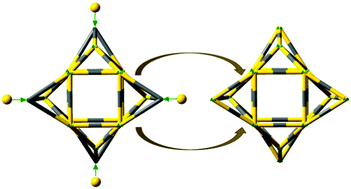Probing the stability of neutral and anionic transition-metal-doped golden cage nanoclusters: M@Au16 (M = Sc, Ti, V)
Abstract
The golden Au16q (q = 0, −1) cage is doped systematically with an external atom of different valence electrons: Sc, Ti, and V. The structural, electronic, and magnetic properties of the doped clusters, M@Au16q (M = Sc, Ti and V; q = 0, −1) are investigated using the Saunders “Kick” (SK) global search technique combined with density-functional theory (DFT) calculations (SK-DFT). It is found that the closeness of the calculated vertical/adiabatic detachment energy for Ti-doped and V-doped (3.09/3.16 eV for Ti-doped, and 3.31/3.38 eV for V-doped) is consistent with the negligible geometry change between the anionic and neutral ground state structures. The characteristics of the Sc@Au16− cluster includes its remarkably high average binding energy and doping energy, which reflects its high stability. The different spectral features between doped M@Au16− and pure Au16− clusters indicate endohedral structures with larger distortion from the parent Au16− cage for the doped clusters. The s electrons of the Au16 cage are observed to transfer to Sc, Ti and V atom for doped M@Au16q clusters by natural population analysis (NPA). The magnetic moment of the impurity Sc/Ti/V atom is somewhat quenched. Furthermore, the electron localization function analysis does not reveal strong interactions. The current work shows that the electronic properties of the golden cage can be systematically tuned through doping.


 Please wait while we load your content...
Please wait while we load your content...